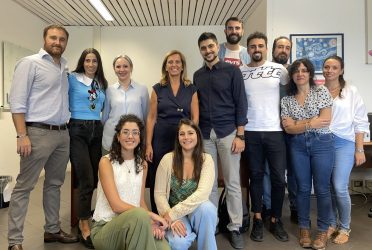Visit and seminars by Prof. Simona Binetti, Dr. Vanira Trifiletti & Dr. Giorgio Tseberlidis from MIB-SOLAR
Introduzione attività del centro di ricerca MIB-SOLAR – Prof. Simona Binetti, Università di Milano Bicocca, Direttore MIB-SOLAR
Oct 13th 2023, COB2 Room at 11:00 am
Seminar: “Quasi-Zero Dimensional Halide Perovskite: Status and Opportunity” – Vanira Trifiletti
Many technological advances have been made possible by nanoscale phenomena: unique optical and electronic phenomena occur on length scales smaller than 10 nanometres. Halide perovskites can self-assemble into low-dimensional bulk materials, thus combining easy synthesis processes, low production costs and the possibility of exploiting the charge confinement phenomena. In low-dimensional perovskites, metal halides are partially isolated from each other by the cations: the isolation level generates the two-, one-, or quasi-zero dimensional confinement. In particular, quasi-zero dimensional perovskites have been explored for several applications (e.g., photovoltaics, thermoelectric, lasing, photodetectors, memristors, capacitors, LEDs). In this seminar, Vanira Trifiletti will talk about the recent progress in the knowledge of these materials and their applications, showing some preliminary results on thermoelectrics and sensing.
Seminar: “The double life of a kesterite absorber: photovoltaics vs photocatalysis” – Giorgio Tseberlidis
Among the most promising, emerging, thin-film photovoltaic technologies, we find sulfide-based
kesterite Cu2ZnSnS4 (CZTS). This p-type, environmentally sustainable semiconductor, based on earth-abundant elements, shows excellent characteristics especially in terms of absorption coefficient. However, issues like inner defects of the material and a non-optimal band alignment with the toxic but conventionally used CdS buffer layer, limit the device performances to record efficiencies not exceeding 11%. In the last few years, several efforts have been made to find a suitable buffer layer alternative to CdS, and ZnSnO has been reported as one of the best performing, while only recently TiO2 has been suggested as a suitable partner for CZTS through device simulations. Besides thin films, Kesterites can be produced also as nanoparticles and employed as Hole Transport Layers (HTL) in perovskite solar devices with the aim to decrease their production cost and, most importantly, to stabilize them in the meantime. In recent times, the same kesterite thin-films and nanoparticles have been also reported as a good photo/electro-catalyst in water splitting reaction and their high photoactivity has been registered also in the photodegradation of organic dyes in aqueous media. In this talk, I will show you how it is possible to produce an efficient Cd-free kesterite solar cell featuring only TiO2 as buffer layer and I will also focus on the stability gained by perovskite solar cells featuring CZTS as HTL. Last but not least, I will demonstrate that our kesterites nanoparticles can be efficiently used as catalysts in the photodegradation of water micropollutants.


